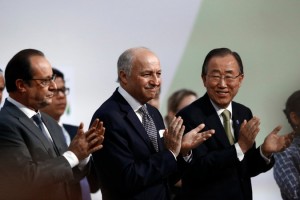
After 23 years, 21 international meetings and tens of thousands of speeches, the world has established a framework to deal with the growing threat of climate change . While the road ahead will be very difficult and it is far from clear whether the process will be successful, the fact that there is an agreement is a monumental first step.
Main Points of the Paris Agreement
For those of you who have not been following this process I will highlight what I understand to be the basic ideas of the agreement.
- In the first place, the agreement is based on the idea that the world must limit the total amount of greenhouse gasses in the atmosphere, especially CO2, in order to make it less likely that the overall temperature of the planet increases too much as compared to its pre-industrial levels. One issue over the last two weeks was to agree on the target and the final wording is “well below 2ºC” and the 1.5ºC target is also mentioned as a lofty goal. To achieve this result, the world will need to cut emissions enormously over the next 10-20 years.
- In the second place, the agreement puts national sovereignty at the heart of future action on climate change and the process is based on the idea that every country will do what it can to help solve the problem. Currently, most countries have committed themselves to cut or, in the case of China, stabilize emissions by 2030.
- The third key issue is that the agreement recognizes explicitly the fact that the developed world has caused much of the problem to date and that the economic development of the developing world should not be blocked in order to limit the impact of climate change. The mechanism to do this, discussed in last week’s post, is to transfer at least $100 billion to developing countries to pay for low carbon energy and maintain forest cover.
- The fourth aspect which I find to be important is that the agreement pushes much of the most difficult issues, such as reducing the voluntary commitments, to future meetings and conferences. As they stand now, for example, the sum total of the national plans is not enough to keep the world below the 2ºC target and bigger cuts will have to be made in the future. In another example, the $100 billion is supposed to start flowing after 2020.
- The last point is that the agreement sets up a number of institutions to manage the system that is being created and to implement the agreement. All of these institutions need to be built, staffed and funded.
The Road Ahead: the U.S. example
Written into the agreement is a window of one year (starting April 22, 2016) for countries to sign the deal.

In the United States because the commitments are not binding, it appears that the agreement will not require ratification by the U.S. Senate. This process requires at least 2/3 of the 100 Senators to support the deal and currently the Senate has 54 Republicans, 44, Democrats, and two independents including Vermont’s Bernie Sanders and Maine’s Angus King. Assuming all of the Democrats and Senators Sanders and King supported the Paris Agreement, 21 Republican Senators will also have to go along with it!
As that would be politically impossible in the current environment, Secretary John Kerry and his team made sure that the agreement would not have to go through this process! Back in 1920, President Wilson (a Democrat) was 7 votes short of ratification of the Treaty of Versailles due to opposition from a number of Senators including Republican Henry Cabot Lodge and President Obama was careful not to suffer the same fate!



The climate change is a reality, im from Spain and it´s not normal that in December we have 20 degrees. Year by year there are few winter than in previously years.